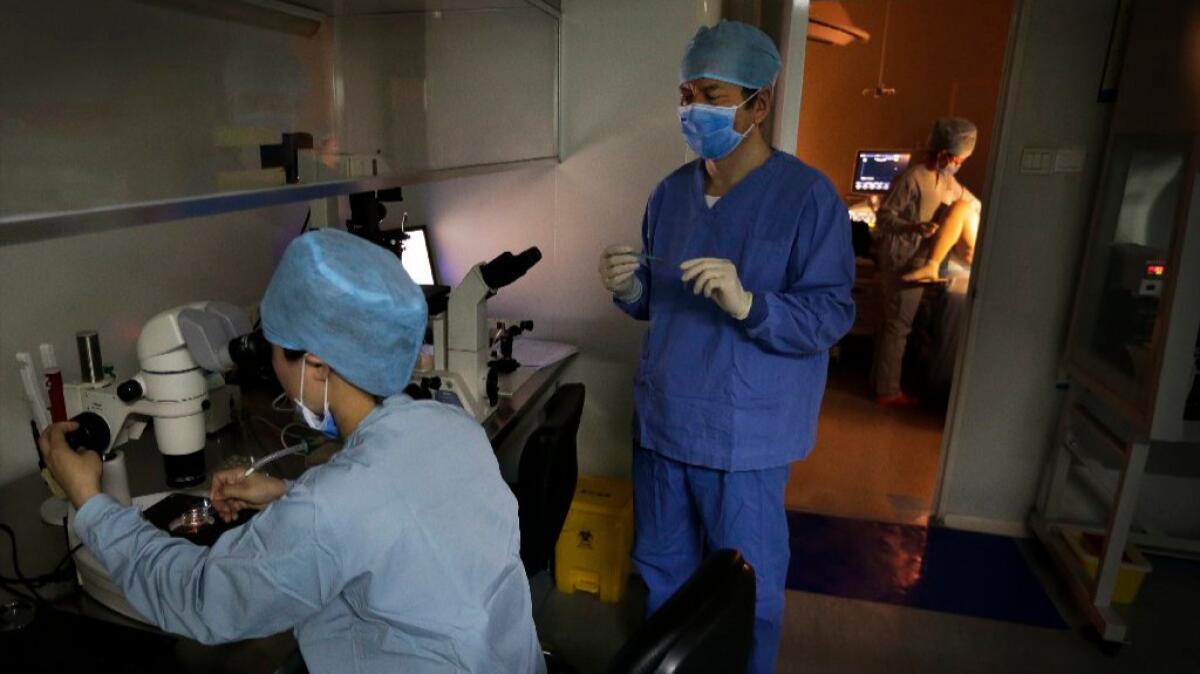In IVF, frozen embryos may lead to more live births than fresh embryos

Most women who do IVF are impregnated with a fresh embryo. However, a new study suggests that using a previously frozen and then thawed embryo may have a better success rate.
In a randomized trial of 1,508 women undergoing IVF for the first time, the researchers found that 49.3% of those who used frozen embryos gave birth to a baby, compared with 42% of those who used fresh embryos.
The work, led by Dr. Zi-Jiang Chen of the center for reproductive medicine at Shandong Provincial Hospital in China, was published Wednesday in the New England Journal of Medicine.
More than 5 million people worldwide got their start in life thanks to in vitro fertilization, according to the study authors.
The process begins when doctors harvest eggs from a woman and mix them with sperm to create a fertilized egg, or zygote.
After a few days, the zygote begins to divide, becoming an embryo. This embryo can be implanted in a woman’s uterus right away or frozen for use later.
The new study is one of the largest yet to look at the difference between using fresh embryos and frozen embryos in IVF. The data were collected from fourteen medical centers throughout China from 2013 to 2015, and all participants were followed throughout the duration of their pregnancy.
The authors found little difference in pregnancy rates among women who used fresh embryos and those who used frozen ones. However, they did see a significant difference in how likely these women were to stay pregnant.
Nearly 33% of women who had a fresh embryo transfer lost the baby over the course of their pregnancy, compared with 22% of those who were implanted with a frozen embryo.
Frozen embryos were also associated with a higher birth weight in babies.
All the women who participated in the study were diagnosed with polycystic ovary syndrome, or PCOS. This condition results in women having several small fluid-filled sacks in their ovaries that look like cysts.
It is often associated with obesity, as well as increased levels of male hormones that can cause excessive hair growth and acne. Women who have PCOS also have irregular periods and cannot get pregnant except through IVF.
Participants in the study were randomly split into two groups. One group received IVF with embryos from eggs that had been harvested and mixed with sperm just three days before implantation. The other group waited a month between harvesting and implantation. Their eggs were mixed with sperm and then frozen three days later. A month later, after the woman’s uterine lining had been shed and replaced, the frozen embryos were thawed and then implanted.
The fact that all the participants in the study suffered from the same infertility condition has pluses and minuses when it comes to interpreting the study results, said Dr. Owen Davis, associate director of in vitro fertilization at the Center for Reproductive Medicine at Cornell Medical College.
On one hand, the homogeneous population meant that the study conclusively showed that frozen embryos lead to more live births than fresh embryos in women who have PCOS. However, it is unclear that these findings can be generalized across the wider population.
“Most people doing IVF don’t have PCOS,” said Davis, who was not involved in the study. “I would speculate that the findings are translatable, but we can’t say that for sure.”
The study was not designed to identify why frozen embryos might work better than fresh embryos. However, the authors suggest the success of the frozen-then-thawed transfer might allow a woman’s reproductive system to reset after exposure to all the hormones necessary to harvest the eggs.
The authors also note that there were two still births and five neonatal deaths in the frozen embryo group and none in the fresh group. Although this number is only of borderline significance and could be due to chance, it is still disturbing and the researchers say it warrants attention.
“It could be a statistical blip, but they were responsible and fair with how they dealt with it,” Davis said. “It’s a small red flag and something that does require further investigation.”
Finally, the research team suggests that their findings should lead to a new way of looking at IVF success rates. Currently, registries like those maintained by the Centers for Disease Control and Prevention and the Society for Assisted Reproductive Technology look at clinical pregnancy rate. Because a healthy baby is the ultimate goal of all IVF procedures, the authors say that looking at live birthrates are a better way to measure success.
Do you love science? I do! Follow me @DeborahNetburn and “like” Los Angeles Times Science & Health on Facebook.
MORE IN SCIENCE
Watch sunflowers dance under the sun (Seriously)
The average home has more than 100 kinds of bugs living in it, new study finds
Scientists at Antarctica’s IceCube Observatory find no evidence of sterile neutrino particles




